Excerpts from Jim Conrad's
Naturalist Newsletter
Entry dated March 7, 2024, from notes taken about 2kms south of Higuerillas, Municipality of Cadereyta de Montes; N20.8872°, W99.7718°, elevation ~1660 meters (~5450 feet); on alluvium of valley floor; local narrow belt of vegetation constituting an extreme southern extension of the Chihuahuan Desert, Meridional Subregion; central Querétaro state, MÉXICO
PEARLBERRY
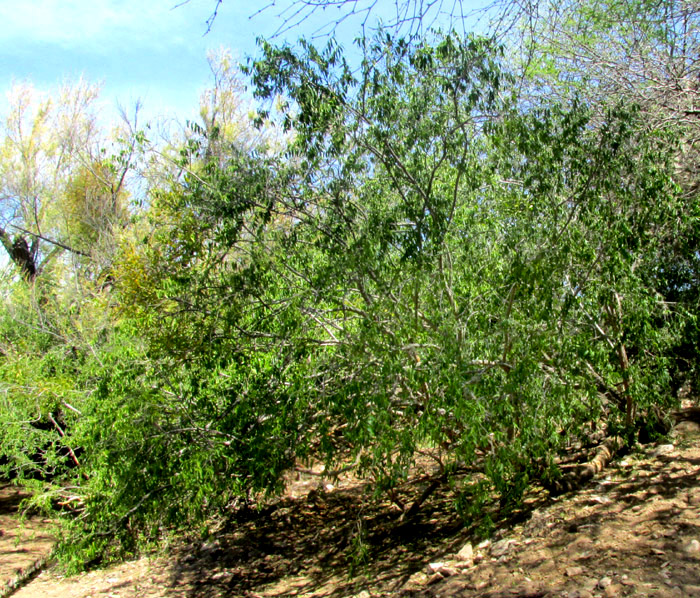
In a shallow valley at the head of which a small spring issued a fair trickle of water into the small, long-established, stonewalled aqueduct seen above at the lower, left corner, small trees with dark green leaves like the one above created a shadowy oasis. By far they were the dominant species in the aqueduct's immediate vicinity, though just meters away they gave way completely to desert scrubland. Their presence all around Higuerillas always depended on nearby water sources, though some of the gullies, or barrancas, they fringed stayed empty except after very infrequent hard rains.
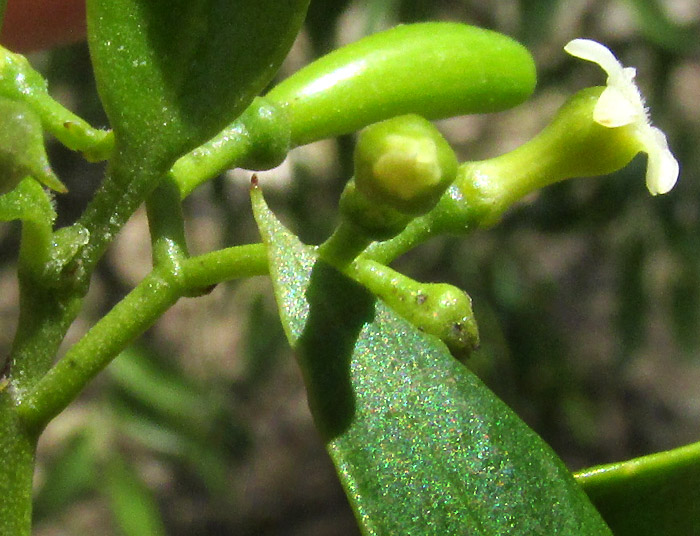
The trees bore sparse, small, white flowers with the distinctive profile seen above. Five corolla lobes abruptly spread from atop a slender corolla tube bulging both at its mouth and at its base. It was reminiscent of flowers of the Oleander/Dogbane Family, the Apocynaceae, as with Mandevilla subsagittata.
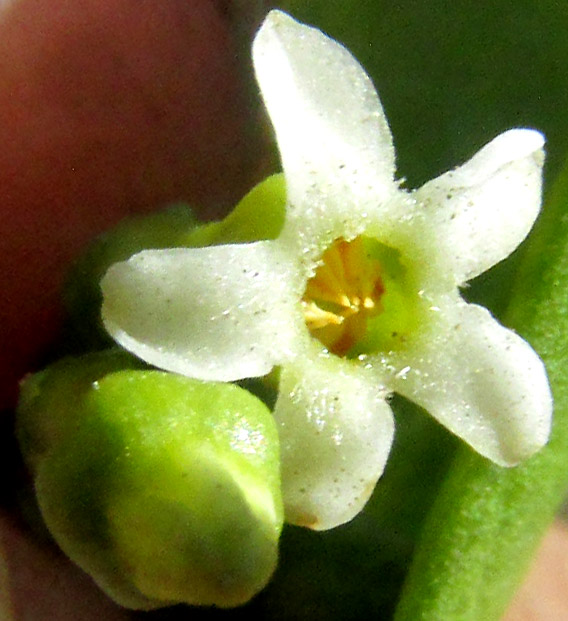
Seen from above, five pointy-topped anthers clustered at the corolla tube's mouth, which also was like the mandevilla vine's flowers.
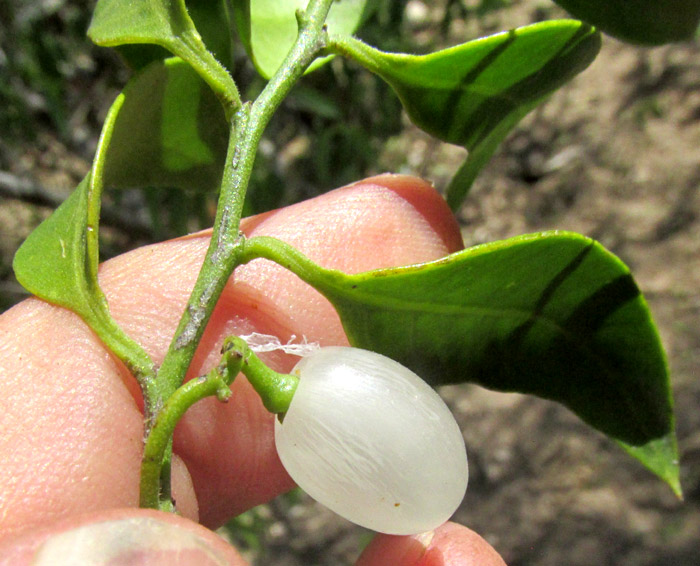
However, the above juicy-white fruit and simple, somewhat fleshy-leathery leaves arising singly at stem nodes, were unlike those on any Oleander Family species I've seen. A leaf was broken apart to see if it "bled" milky sap as Oleander Family species generally do:

It did, but not the milk-white latex often seen in the family. The smaller droplets look clear, but as the droplets grow in size they become milkier.
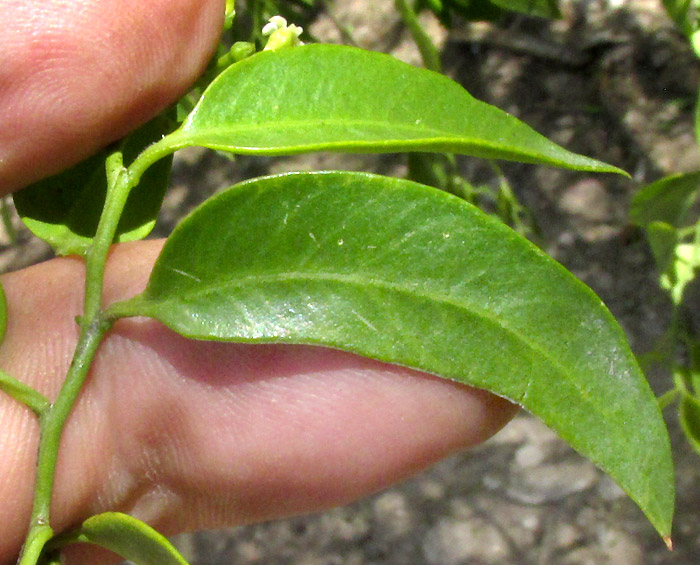
Leaves were curiously curved, or falcate, and often twisted. On the stem, alternately they arose directly above one another -- they were distichous -- and the stems zigzaged from side to side. As seen below, our tree's trunk indicated a hard life, having been knocked down by rampaging floodwaters and/or burros and livestock, whose hoof prints around the tree indicated the animals gathered beneath them for shade.
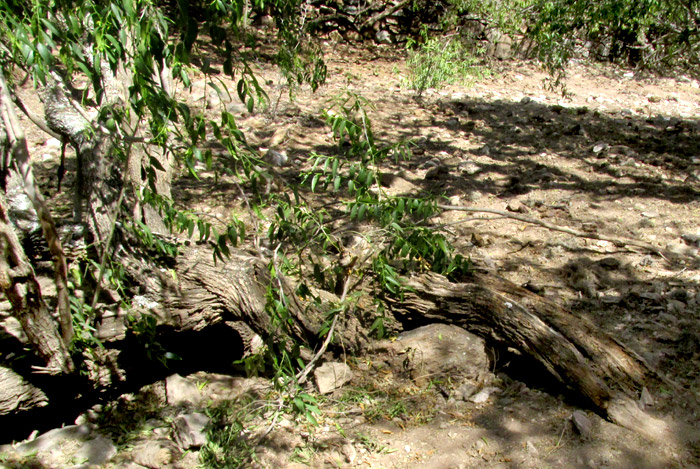
In our Bajío region of upland central Mexico, if you have a member of the Oleander/Dogbane Family that is a tree with leaves arising one per stem node, and the fruit, instead of being of a dry follicle splitting along one side, is a fleshy drupe less than 2cm long (0.8 inch), you have the genus Vallesia. Only one of the eleven currently accepted, tropical American Vallesia species occurs in our area, and that's VALLESIA GLABRA, often known as Pearlberry.
Pearlberry, which the Flora del Bajío describes as abundant in certain microhabitats of dry scrub where the soil is at least sometimes temporarily moist, displays an unusual distribution area. In Mexico, it's found in dry uplands throughout, except in the southern states, plus there's a population in Florida, as well as the Caribbean; it's missing in most of Central America, but widely present in western and central South America.
Sometimes such fragmented distributions are attributed to human dispersal, or suspected of it. Encouraging that suspicion is the fact that Vallesia glabra has a long history of traditional medicinal therapeutic use. The online Atlas de las Plantas de la Medicina Tradicional Mexicana mentions that in Sinaloa state it's used to cure nausea and heartburn caused by overeating, as well as for gas from eating too many beans, or drinking too much water before going to bed, or eating too many corn tamales at night. Also the fruit and leaves are used to treat inflammation of the eyes, measles, rheumatism and muscle pain. The Atlas adds that no clinical studies have been found confirming the efficacy of such uses. Various indigenous peoples in other countries have been documented practicing similar therapies.
However, many members of the Oleander/Dogbane Family are toxic, even as they are used extensively for a variety of unrelated purposes, as outlined in Wikipedia's Toxicity and Uses sections. Very striking when entering our Pearlberries' oasis was that all green herbage in the area within reach of browsing feral burros and wandering cattle had been stripped as high as could be reached -- except on profoundly thorny plants and Pearlberry branches. Vallesia glabra leafy branches often touched the ground, clearly avoided by herbivores.
The 2018 study by Nathalie Castañeda entitled "Vallesia glabra (Cav.) Link" tells us that there's consensus that Pearlberry's high alkaloid and glycoside content may cause convulsions leading to paralysis. Still, I asked a fellow on the road to Higuerillas about the matter, and was told that everyone likes to snack on the white fruits. I did so myself, found the taste a little resiny but OK, and experienced no negative affects. A University of Arizona web page characterizes the plant's toxicity as "benign."
Still, it's apparent that burros and cattle will have nothing to do with the tree, other than gather in its welcome shade, even as people and birds eat the fruits.